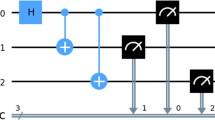Abstract
We analyze the improvement in output state fidelity upon improving the construction accuracy of ancilla states. Specifically, we simulate gates and syndrome measurements on a single qubit of information encoded into the [[7,1,3]] quantum error correction code and determine the output state fidelity as a function of the accuracy with which Shor states (for syndrome measurements) and magic states (to implement T-gates) are constructed. When no syndrome measurements are applied during the gate sequence, we observe that the fidelity increases after performance of a T-gate and improving magic states construction slows the fidelity decay rate. In contrast, when syndrome measurements are applied, loss of fidelity occurs primarily after the syndrome measurements taken after a T-gate. Improving magic state construction slows the fidelity decay rate, and improving Shor state construction raises the initial fidelity but does not slow the fidelity decay rate. Along the way, we show that applying syndrome measurements after every gate does not maximize the output state fidelity. Rather, syndrome measurements should be applied sparingly.




Similar content being viewed by others
References
Nielsen, M., Chuang, I.: Quantum Information and Computation. Cambridge University Press, Cambridge (2000)
Preskill, J.: Reliable quantum computers. Proc. R. Soc. Lond. A 454, 385–410 (1998)
Gottesman, D.: Theory of fault-tolerant quantum computation. Phys. Rev. A 57, 127–137 (1998)
Aleferis, P., Gottesman, D., Preskill, J.: Quantum accuracy threshold for concatenated distance-3 code. Quantum Inf. Comput. 6, 97–165 (2006)
Shor, P.W.: Scheme for reducing decoherence in quantum computer memory. Phys. Rev. A 52, R2493–R2496 (1995)
Steane, A.: Multiple particle interference and quantum error correction. Proc. R. Soc. Lond. A 452, 2551–2577 (1996)
Calderbank, A.R., Shor, P.W.: Good quantum error-correcting codes exist. Phys. Rev. A 54, 1098–1105 (1996)
Steane, A.M.: Error correcting codes in quantum theory. Phys. Rev. Lett. 77, 793–797 (1996)
Bravyi, S., Kitaev, A.: Universal quantum computation with ideal Clifford gates and noisy ancillas. Phys. Rev. A 71, 022316 (2005)
Shor, P.W.: Polynomial-time algorithms for prime factorization and discrete logarithms on a quantum computer. In: Proceedings of the 35th Annual Symposium on Fundamentals of Computer Science. IEEE Press, Los Alamitos (1996)
Kliuchnikov, V., Maslov, D., Mosca, M.: Asymptotically optimal approximation of single qubit unitaries by Clifford and T circuits using a constant number of ancillary qubits. Phys. Rev. Lett. 110, 190502 (2013)
Selinger, P.: Efficient Clifford\(+\)T approximation of single-qubit operators. Quantum Inf. Comp. 15, 159–180 (2015)
Kliuchnikov, V., Maslov, D., Mosca, M.: Practical approximation of single-qubit unitaries by single-qubit quantum Clifford and T circuits. arXiv:1212.6964
Weinstein, Y.S.: Fidelity of an encoded [7,1,3] logical zero. Phys. Rev. A 84, 012323 (2011)
Buchbinder, S.D., Huang, C.L., Weinstein, Y.S.: Encoding an arbitrary state in a [7,1,3] quantum error correction code. Quantum Inf. Proc. 12, 699–719 (2013)
Weinstein, Y.S.: Non-fault-tolerant T gates for the [7,1,3] quantum error-correction code. Phys. Rev. A 87, 032320 (2013)
Weinstein, Y.S., Buchbinder, S.D.: Use of Shor states for the [7,1,3] quantum error-correcting code. Phys. Rev. A 86, 052336 (2012)
Weinstein, Y.S.: Quantum-error-correction implementation after multiple gates. Phys. Rev. A 88, 012325 (2013)
Weinstein, Y.S.: Quantum error correction during 50 gates. Phys. Rev. A 89, 020301(R) (2014)
Whitney, M.G., Isailovic, N., Patel, Y., Kubiatowicz, J.: A fault tolerant, area efficient architecture for Shor’s factoring algorithm. In: Proceedings of the 36th Annual International Symposium on Computer Architecture. ACM, New York (2009)
Acknowledgments
The authors would like to thank G. Gilbert, S. Pappas, and D. Stack for insightful comments. This research is supported under the MITRE Innovation Program.
Author information
Authors and Affiliations
Corresponding author
Rights and permissions
About this article
Cite this article
Weinstein, Y.S., Chai, D. & Xie, N. Improving ancilla states for quantum computation. Quantum Inf Process 15, 1445–1453 (2016). https://doi.org/10.1007/s11128-015-1225-4
Received:
Accepted:
Published:
Issue Date:
DOI: https://doi.org/10.1007/s11128-015-1225-4




